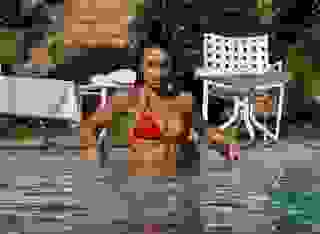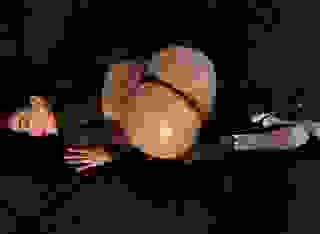Note: You can change font size, font face, and turn on dark mode by clicking the "A" icon tab in the Story Info Box.
You can temporarily switch back to a Classic Literotica® experience during our ongoing public Beta testing. Please consider leaving feedback on issues you experience or suggest improvements.
Click hereIf our true self is Atman, pure consciousness, is there any Brahman, any larger Consciousness for it to merge in, or be identical with? In recent times, most scientists have turned their backs to the concept of Deity and a Creator. Arguments for a Designer have largely been abandoned as regressive. After all, if there was a Designer, who designed Him? If there was a "preuniverse," then what preceded that?
The noted mathematician and physicist Sir James Jeans, pondering the subtleties of the mathematics of laws of physics and the seeming dependence of material events upon observation by conscious minds, observed, that the "universe begins to look more like a great thought than a great machine" (Jeans, 1937, p. 122). Another great physicist, Sir Arthur Eddington, remarked, "the stuff of the world is mind-stuff" (Eddington, 1920/1959, p. 200).
Indeed, the base reality of the world appears to be one of quantum probability waves inhabiting an abstract, multidimensional mathematical space rather than the solid, marble-like electron and protons zipping around in a four-dimensional spacetime continuum that we imagine to be the firm underpinnings of our material existence. The mathematical complexity and beauty of the laws of the quantum mechanics are remarkable. It does indeed seem as though the Creator is, as both Jeans and Einstein thought, a great mathematician. As Henry Stapp says, under quantum mechanics, the world has "an essentially 'idea-like' structure" (Stapp, 2005, p. 73). Stapp's remarks are echoed in an editorial in Nature, the flagship journal of orthodox science, in which Richard Conn Henry points out that modern physics has demonstrated that the universe is "entirely mental" in nature and that "nothing exists but observations" (Henry, 2005, p.29).
But if the universe is a thought, whose thought is it anyway? In recent years, a seemingly endless succession of physicists have observed that the laws of the universe and the initial conditions set at the time of its creation seem extraordinarily finally tuned to support the evolution of complex life forms and hence conscious observers (see Barrow & Tipler, 1986, or Livio and Rees, 2005). This seeming evidence of intelligent design is often referred to as the anthropic principle. Was the universe created as a vast cosmic amusement park? And why go to trouble of designing such an elaborate "roadside attraction" unless One intended to enjoy it Oneself, if only vicariously? Are our individual consciousnesses just aspects of the Creator's (or Creators') consciousness, lost in an unimaginable form of contemplation of the myriad creatures It has managed to generate from Its mathematical inventions, much as we may become lost in the adventures of a goldfish in the bowl in our living room?
The anthropic principle is based on the observation that the laws and initial conditions of the universe must be extremely fine-tuned to support life as we know it (i.e. carbon-based life forms). But there may be other forms of life (e.g., nucleon-based) that may arise under different conditions. Also, there may be multiple universes created, so that we necessarily find ourselves in a universe capable of supporting conscious observers, with initial conditions and laws that would seem improbable had only one universe been created with a random assortment of physical laws and initial conditions. Guth and Kaiser (2005), for instance, note that cosmic inflation (the currently favored model of cosmogenesis) may produce "pocket universes" in each of which the fundamental laws of physics might be different. Again, we of necessity inhabit a pocket universe that is capable of supporting the existence of conscious observers. Still, one must explain the laws and initial conditions that gave rise to cosmic inflation in the first place.
One might imagine that a consciousness so complex and vast as to be able to create (perhaps literally dream up) such a startlingly wonderful (and frightening) world as this one might well become bored with its omniscience and may wish to lose itself in its creation, if only temporarily. It may need to fragment itself and temporarily shed much of its omniscience to accomplish this. We too might well begin to stagnate and become bored if we were to somehow become immortal and become trapped in our present bodies and mired in our present personalities and situation for all eternity. Death may be the rope thrown to free us from the quicksand of our current identities.
Beyond the Veil of Maya
We awake from the Dream of Atman and Brahman to find ourselves in still yet another, but this time possibly the final, dream. We are, exactly as in the dream from we have just awakened, each of us specks of consciousness adrift in a universe whose vastness defies our understanding (if we can even be said to have an "understanding" in any real sense of the word). There are as yet no planets, no stars, only a rapidly expanding rush of matter and light. The universe is but only seconds old. We may have come from a place before the universe, but being disembodied with no notepad or brain on which to record and preserve the events of this prelife, our memories of such a place are lost. For all we know, and we don't know much at his point, we may have just been fused together in some great computer of our own construction, of unimaginable computational and physical power, in a "Manhattan project" designed to produce a very Big Bang indeed (at least from our present perspectives). We are adrift in a rapidly expanding spacetime designed to captivate us in a way that is even more amusing and terrifying than any Hollywood concoction our current primitive technologies can produce. However, that all lies in the distant future. Now, with our memories lost along with our cosmogenic computer, we drift among the beautiful clouds of quantum waves, admiring their beauty, touching them, drawing them this way and that as the potential universe is actualized. Our consciousness is like that of a quark lost in a swarming buzz of photons and gluons.
As Tim Hill points out in a letter to the Editor of the Skeptical Inquirer (Hill, 2005), the vast emptiness of space is totally hostile to human observers with its lack of air, pockets of intense radiation and unimaginably high temperatures, not to mention the total absence of fast-food establishments. If the anthropic principle is valid, Hill suggests, the overwhelming evidence surely suggests that the universe was created for beings that exist in the vacuum of space, not for the amusement for a handful of abnormally smart "geek" apes confined to one tiny speck in a cold dark corner of a comparatively uninterested and desolate cosmos.
Perhaps then, we are more akin to antiprotons than to angels, small islands of consciousness born to force the amorphous clouds of quantum possibilities into the crystallized raindrops of actualized events. In the view of many interpreters of quantum mechanics, observation by consciousness is what causes such quantum collapse (i.e., collapse of the state vector containing an array of possibilities into one definite outcome). Walker (2000) has even proposed the existence of "mini-consciousnesses" or "proto-consciousnesses" that govern the collapse of quantum vectors that are remote from human observers.
Indeed, some physicists (e.g., Wheeler, 1983) have suggested that the universe itself, conceived as a quantum process, could not have come into existence without some conscious observer to force the collapse of state vectors and thus to give rise to a definite history of the universe. Wheeler terms this view the "participatory universe." Wheeler notes that this view may explain the fact that the initial state and physical laws of the universe seem finely tuned to support the existence of conscious observers. Potential universes that do not support the presence of conscious observers could not become actualized in Wheeler's view, as there would be no conscious observers to collapse their state vectors in the proper "direction" to create such a history.
But perhaps those observers are more akin to Walker's "proto-consciousnesses" than to human beings. If physics suggests anything, it is that the fundamental constituents of the universe are more likely to be very small in comparison to the human observers that formed the center of the medieval view of the cosmos. Our essential selves are more likely to resemble an electron than a human body.
After our dispersal at the time of the Big Bang, we have surfed the quantum waves, finding our selves in neutron stars, methane oceans on moons of gas giants, exploding in supernovae (the matter comprising our physical bodies was formed in such explosions), shooting out of volcanoes, condensing into rocks, shepherding the bodies of amobea, gazing out of worried eye of a stegosaur, stretching with the leaves of a sequoia. Through much of this, our consciousness would be dim, as we float in a universe largely separated from our fellow monads, deprived of any physical template to hold our memories or any hormones to drive our wishes and aspirations. But time is on our side.
As the debris of supernovae cooled and their ashes condensed once again into stars and planetary systems, on one remote outpost (and probably on a virtual infinity of outposts), the physical templates (and the complex assemblages of our essential selves) grew more complex. With the first protozoa, we began to gather, and after eons we were collected in assemblages in whales and crows and octopodes and in at least one malcontented bipedal ape.
Our common conception, and one that forms part of the Dream of Atman and Brahman is that we are each a single conscious self (field of consciousness) which in some mysterious manner became attached to our brains shortly after our conceptions and will persist in those brains until we die. But our brains are powerful and unimaginably large in comparison to our single-celled ancestors, who, we might suppose, had the glimmerings of consciousness. Our brains and bodies are in essence a colony of billions of amoebas. Many of us may ride in a single brain. For instance, when a human brain is split into its two hemispheres by severing the corpus callosum (the primary bundle of neural fibers connecting the two hemispheres), two fields of consciousness seem to exist, sometimes with such differences in motivation that the right hand (controlled by the left hemisphere) may forced to grab the left hand (controlled by the right) in order to prevent the latter from carrying out an assault on one's spouse.
In fact, the findings of split-brain research are precisely the evidence Patricia Churchland uses to refute the existence of a nonphysical self or soul in human beings (Churchland, 2002, pp. 46-47).
Churchland is likely correct so far as the "single soul" theory goes; but the evidence suggests that multiple centers of consciousness or "souls" may exist within a single brain, with each of them falling under the delusion that they are the single center that is "in charge of" the body."
Two conscious selves may, however, not be enough, as there are more ways to divide up (or dissociate) a brain than are dreamt of in the classical split-brain paradigm. Take for instance the phenomenon of blindsight. "Blindsight" is a term coined by Lawrence Weiskrantz (1986) to describe a syndrome in which cortically blind subjects respond appropriately to visually presented stimuli even though they report no conscious awareness of such stimuli. Cortical blindness refers to blindness that is a result of damage to the visual cortex in the occipital lobes of the brain. Even though the eyes of such patients may be normal, they may be blind in part of their visual field because of such damage to their visual cortex. If you present a small dot of light to such patients in the blind areas of their visual fields, they will say that they saw nothing. However, if you ask them to just take a guess by pointing to where the dot of light might have been, they frequently point at the exact location that the dot occupied. If you present erotic pictures to such a patient in the blind area of the visual field, the patient may blush or giggle or say things such as "That's quite a machine you've got there, Doc!" Many researchers have speculated that blindsight is mediated by a secondary visual center in a subcortical area of the brain known as the superior colliculus. Thus, there may be multiple centers of consciousness within a single human brain.
Jonathan C. W. Edwards (2005) and Willard Miranker (2005) have even proposed that that each single neuron in the brain is associated with its own center of consciousness. Due to the complexity of the input to each neuron, each such center of consciousness would likely identify with the body as a whole and fall under the delusion that it is the single center conscious self "in charge" of the whole body.
This view leads naturally to panpsychism, the view that consciousness pervades the universe. Many of the most prominent practitioners of human thought, including Leibniz, Spinoza, and Alfred North Whitehead have proposed that consciousness pervades all things and that, at root, the universe consists of a plenitude of spheres of pure consciousness, or "monads" in Leibniz' terminology. In the early stages of my intellectual career, I scoffed at the notion that a rock might be consciousness. How silly my naive rejection appears in retrospect. It is a shame that the cosmos of Leibniz, Spinoza, and Whitehead has to be "discovered" anew by each generation, due to the fact this point of view is drowned in a seemingly ubiquitous sea of irrationalism on the part of all sides in the debate over religion.
One advantage of the pansychist view is that it does not need to explain how consciousness arose from insentient matter, which is perhaps the most vexing, fundamental and seemingly unsolvable problem confronting modern science and philosophy. Consciousness was here from the start. It is angels all the way down.
Our bodies are composed of a vast number of cells and bacteria, with only a fraction of them from our own species. In fact, our bodies seem more akin to a ferocious battleground for microorganisms, which are replaced from minute to minute, than to a unified entity. If one is to grant consciousness to animals "all the way down," could not our white blood cells possess a (possibly dim) consciousness capable of recognizing their foes and engulfing them? Might plants be conscious? While they seem less complex than us, rice plants contain upwards of 50,000 genes, compared to a measly 20,000 to 25,000 for a human being. Thus, appearances may be deceiving. Is it inconceivable that plants possess a glimmer of consciousness, perhaps operating on a much slower time frame than we do? If one watches plants in a speeded up movie, their behavior seems almost animal-like as they open and close their petals and stretch to capture the maximum sunlight. Do plants experience thirst when deprived of water (to say nothing of the Venus flytrap, which might be expected to experience pleasure as it emits a contented burp)? It is true that plants have no nervous systems; however, might we not be biased toward neurons because of our present unfortunate location? McGinn (1999) for instance begins his book The Mysterious Flame with a short story in which future silicon-based artificial intelligences stumble across the Earth and are astounded to find lumps of meat that can think (our brains).
Our brains are essentially comprised of colonies of single-celled animals (our neurons). What if these animals could move? Might their collective then be considered an even more complex brain?
Hölldobler and Wilson (2008) propose that communities of insects comprise "superorganisms" and that evolutionary selection acts on the colony as a unit, rather than on the on the individual insects. Can the whole of humanity be considered as a single super-brain, perhaps associated with global spheres of consciousness? Goldberg (2009) has even suggested that in the future the Internet may develop into an "advanced intrinsic consciousness" (p. 54).
And what of the famous thermostat? Can it be said to be aware of the rise of heat? Might rocks as they weather and absorb radiation experience consciousness on an extremely slow time span? As I work in my current job I sometime catch glimpses of the patterns on my Windows media player that resemble the light show at the end of Kubrick's 2001: A Space Odyssey. I sometimes think that the consciousness of a rock might be something like that (as well as how much more peaceful it would be to be such a rock rather than to return to the Microsoft Word window at which I am toiling). Thus, the very dust from which we were born and into which we will die may well still carry still the stuff of mind.
In view of the complexity of the quantum mechanical wave governing the behavior of individual physical particles, it might not be too big of a stretch to hypothesize that a single proton might possess consciousness, and protons are essentially immortal.
Elementary particles such as electrons and quarks sometimes become embedded in physical brains; these particles persist and remain stuck over "long" time intervals such as minutes and hours. These particles appear, like our individual consciousnesses, to be indivisible (leaving aside the possibility of subquarks for the moment). If an electron can "incarnate" in a body for a period of time, then be expelled, and then be "reincarnated" in another body or physical system, then so might we. We may ourselves be material or quasi-material entities that can become stuck in individual brains on a temporary basis. We may be a particle or field already known to physical science, although it is more likely we are an entity yet to be discovered and explained. We directly experience ourselves as single unified fields of consciousness that persist through changes in our brain states and bodily composition over periods of at least hours. We think we persist as the same selves over the lifetimes of our bodies. In this we may be wrong. If memories are, as an overwhelming body of scientific evidence indicates, stored as patterns of synaptic connections among neurons in our brain, how do you know that you are the same field of consciousness that inhabited your body when you fell asleep? If you can become attached to your brain shortly after conception (or in the view of some people at birth) and become detached from it at the moment of death, it stands to reason that you can also become attached to it long after birth and leave it well before death. Our association with our bodies may be only temporary. We may be breathed out and breathed in like so many oxygen atoms. Indeed, while many philosophers (such as Descartes) have thought that minds or souls are not extended in space and time and hence immaterial, the fact that we find ourselves stuck in physical bodies occupying in particular locations in space and (even more mysteriously) located at a particular moments in time, suggests that we too must (at least partially) be residents of spacetime ourselves, if only temporarily.
If we are continually being recycled, then when we wake in the morning, we may not be in the same bodies (or objects or plasma fields) that we were in the day before. If, as the overwhelming body of modern research in neuroscience indicates, our memories, thoughts and emotions are largely a function of our brain states, we would not remember our existence as, say, a crow the day before. Our previous "memory pad," namely the crow's brain, is lost to us. We cannot find those memories in the same way that we cannot access a telephone number written on a misplaced piece of paper. The telephone number and the pad it was written on are not parts of our essential selves. Neither are we the memories stored in the stored in the brain of the crow that now perches outside our window or the memories and personality traits stored in the new human brain in which we have just awakened. What we will remember are the memories stored in that new human brain (sometimes after a period momentary of confusion upon awakening). We will feel the emotions caused by the intense firing of our midbrain neurons and the hormones and neurotransmitters rampaging through our cerebral cortex. Accessing the brain's memories of our sixth birthday party, we will immediately come to the conclusion that we have inhabited this brain and body for decades. The brain has evolved to serve the body and we now made to serve that purpose as well, overwhelmed by the delusion that we are the Person, that is to say, the body and the memories, thoughts and emotions that result from the neural activity of that body's brain. We think we are in sole command of the body, whereas in fact our nerves, the neurochemical soup in which they bathe, as well as numerous other centers of pure consciousness also mired in the same brain, may have as much or more to say about the fate of the body than we do. In short, we fall under the illusion that we are the Person, the physical body that continues from birth to death, and the stream of memories, thoughts and emotions that courses through it, rather than the centers of pure consciousness that we are.








